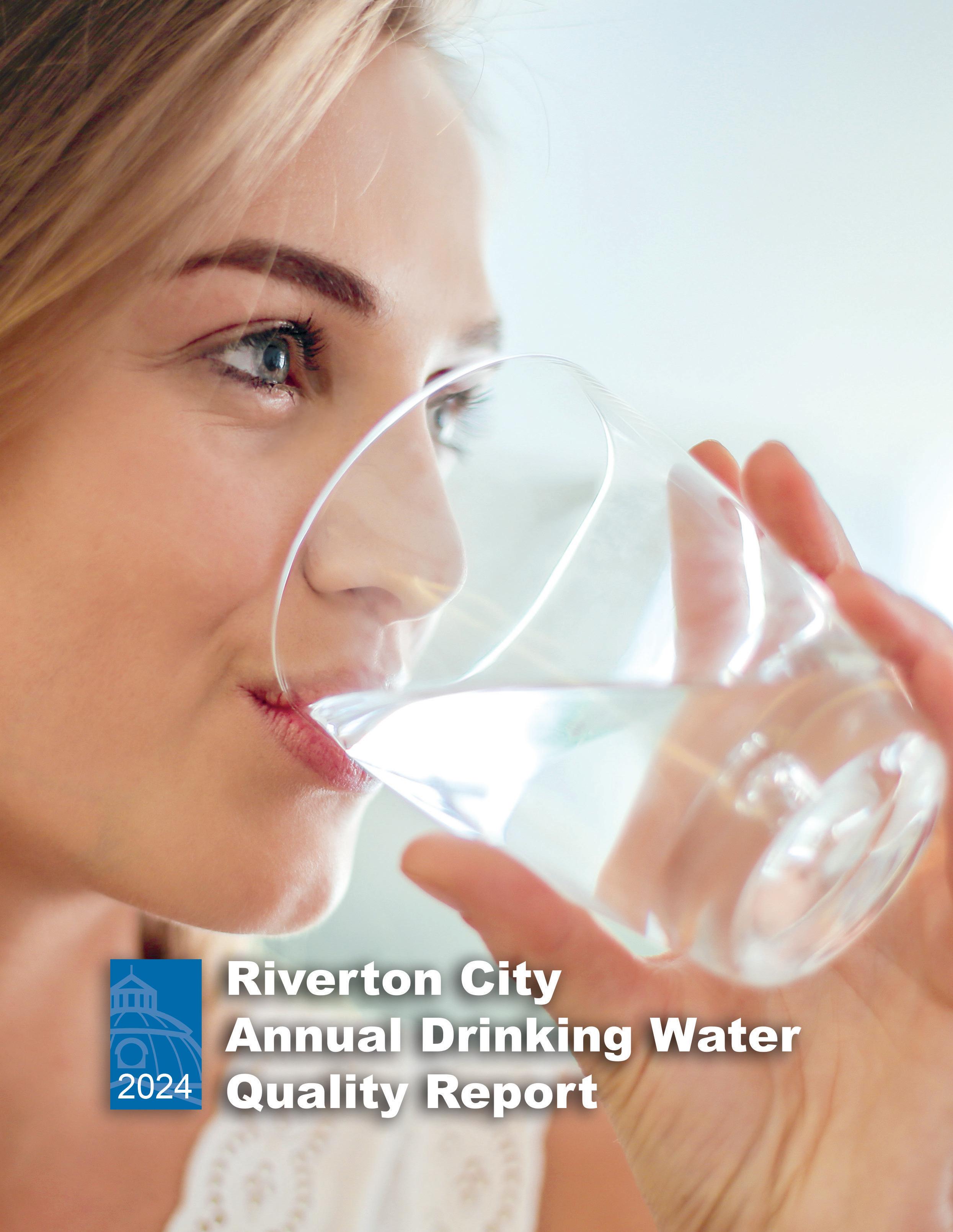
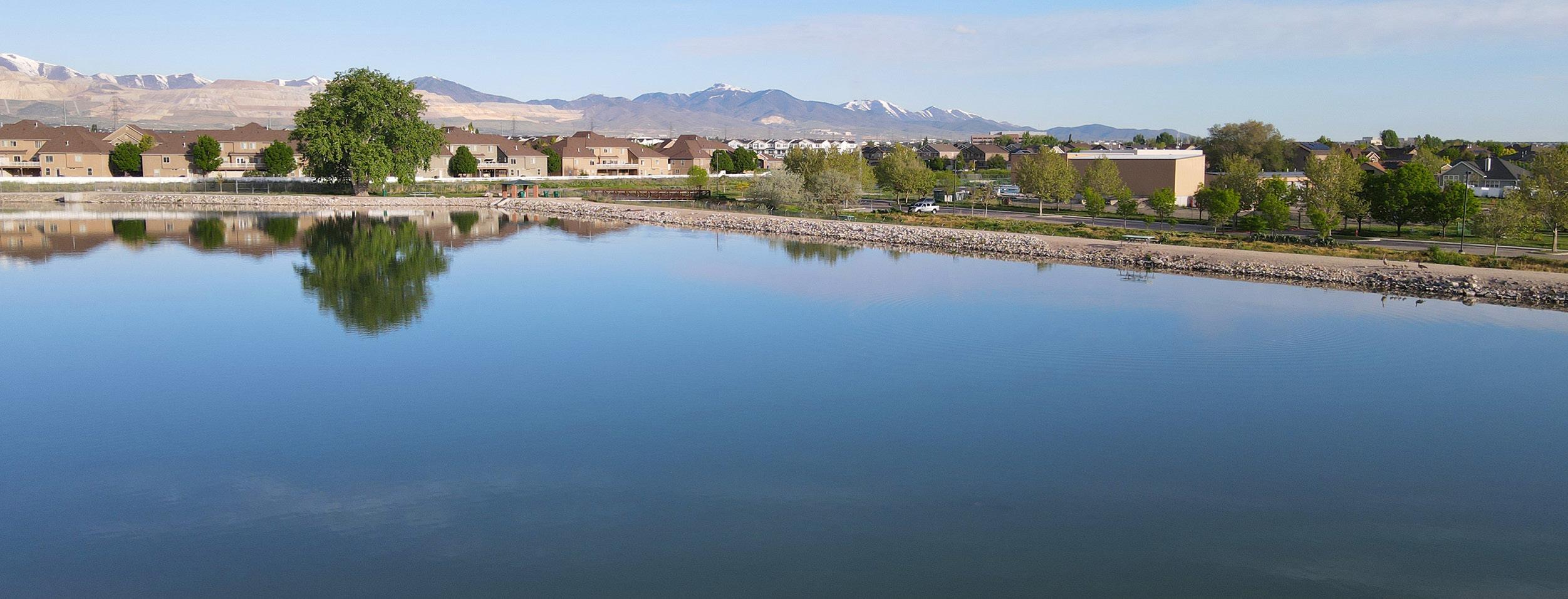



Riverton City is pleased to present to you, our customer, with the most current Drinking Water Quality report. This report is designed to inform you about the quality of the water and services we deliver to you every day. Our constant goal is to provide you with a safe and dependable supply of drinking water. If you have any questions about this report or concerning your water utility, please contact the Riverton City Water Department at 801-208-3162 or email water@rivertonutah.gov
Conservation
Riverton is committed to finding and implementing ways to help minimize its water footprint. Training and educating on more water friendly choices for landscaping, more efficient ways to water, updating home or business with water saving fixtures. By utilizing programs that are offered by Jordan Valley Water Conservancy District and Salt Lake County, Riverton and it’s residence can offset some of the cost of becoming more efficient and water conscientious.
Riverton City provides its consumers with 100 percent purchased water through 9 connections with Jordan Valley Water Conservancy District. Jordan Valley Water Conservancy District’s main water sources include Deer Creek and Jordanelle reservoirs, as well as the Provo River watershed, and some ground water sources/wells. JVWCD delivered over 2.02 billion gallons of water in 2024 to Riverton a increase of nearly 239 million gallons from 2023.
Corrosion of pipes, plumbing fittings and fixtures may cause lead and copper to enter drinking water. To assess corrosion of lead and copper, Riverton City
conducts tap sampling for lead and copper at selected sites every 3 years. Riverton City has not had to treat its water to control corrosion and has not identified any corrosion issues in its system.
Riverton City has completed an initial Lead Service Line Inventory. The inventory is information on the service lines that connect the city’s water mainlines to the buildings/houses as well as the water pipes inside the property. The information was gathered by the following methods: Reviewed Water Department records, Visual Inspection at the Meter Pit, Customer Self-Identification, Mechanical Excavation, Vacuum Excavation, and by the states Predictive Modeling guidelines. Buildings/Houses built after April 1989 are omitted from inventory verification do to being built after lead ban was implemented. After complying with State and the EPA, Riverton’s Service line Inventory is considered Non-lead. Riverton will continue gathering the information on the address and locations the Predictive Modeling was used for.
Water samples taken in September 2024 had 1 sample return with a “+ coliform bacteria”. After resampling the location that had a “+” hit as well as a
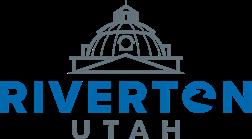

connection before it, after it and the water source of where the water came from there was no sign of an issue. Retesting confirmed that total coliform bacteria was not present in the distribution system. The sample that tested positive was most likely due to contamination during the collection process. Coliforms are bacteria that are naturally present in the environment and are used as an indicator that other, potentially harmful, bacteria may be present. Total coliforms are common in the environment and are generally not harmful themselves. The presence of these bacteria can indicate that the water may have been contaminated with organisms that can cause disease. Some symptoms may include diarrhea, cramps, nausea, and possible jaundice, headaches and fatigue. When the monthly samples confirmed the presence of total coliform bacteria, we took steps to identify and correct the problem. Subsequent monthly sampling has confirmed the absence of total coliforms in the water system.
The Drinking Water Source Protection Plan for Riverton City is for The Green Well and is available for your review. It contains information about source protection zones, potential contamination sources and management strategies to protect this future drinking water source. Our source has been determined to have a low level of susceptibility from potential con-
tamination sources such as The Jordan River which has varying flows and the nearby Residential homes which has uncontrolled application of Herbicides, Pesticides and Fertilizers. Riverton City has also developed management strategies to further protect our source from contamination. Please contact us if you have questions or concerns at 801-208-3162 or email water@rivertonutah.gov.
Jordan Valley Water Conservancy District has a Drinking Water Source Protection Plan. This plan covers the sources that Jordan Valley Water uses to provide water to its customers like Riverton City. Please visit Jordan Valley Conservancy District web page for more information.
There are many connections to our water distribution system. When connections are properly installed and maintained, the concerns are very minimal. However, unapproved and improper piping changes or connections can adversely affect not only the availability, but also the quality of the water. A cross connection may let polluted water or even chemicals mingle into the water supply system when not properly protected. This not only compromises the water quality but can also affect your health. So, what can you do? Do not make or allow improper connections at your homes. Even that unprotected garden hose lying in

the puddle next to the driveway is a cross connection. The unprotected lawn sprinkler system after you have fertilized or sprayed is also a cross connection. When the cross connection is allowed to exist at your home, it will affect you and your family first. If you’d like to learn more about helping to protect the quality of our water, call us for further information about ways you can help.
Riverton City is dedicated to providing our residents and customers with safe, clean drinking water. Maintaining a Backflow Prevention Program is an essential key to accomplishing this goal.
The city and its residents share a joint responsibility to ensure all areas of the water distribution system are adequately protected. The city will provide a safe, adequate water supply to the residents who in turn will maintain their plumbing systems in compliance with state and local ordinances, requirements, codes and policies.
Backflow incidents can seriously affect the quality and safety of the drinking water. Backflow is the reverse flow of contaminated water or other substances from a user’s water system back into the public drinking water system. This can occur if your plumbing system is physically connected (also called a cross-connection) to any source of contamination or pollution. Common examples of possible cross-connections include land-
scape sprinkling systems, hose attachments for utility sinks, and garden hoses. Backflow prevention assemblies provide the public water system with protection against contamination or pollution. Riverton City’s Water Department randomly performs assessments of every residential sprinkler irrigation system to determine compliance with the above mentioned requirements. You can email Riverton with your backflow questions anytime at backflow@riverton utah.gov
Riverton City routinely monitors contaminants in our drinking water in accordance with the Federal and Utah State laws. Table 1 shows the results of our monitoring for 2024. It is important to remember that all water sources of drinking water contain some naturally occurring contaminants. At low levels, these substances are generally not harmful in our drinking water. Removing all contaminants would be extremely expensive, and in most cases, would not provide increased protection of public health.
Table 3 lists all of the parameters in the drinking water detected by Jordan Valley Water Conservancy District or its suppliers in the drinking water during the calendar year of this report. The presence of these parameters in the water does not necessarily indicate that the water poses a health risk, unless otherwise noted.


For certain parameters, EPA and/or the State requires monitoring at a frequency less than once per year because the concentrations do not change frequently.
The Unregulated Contaminant Monitoring Rule (UCMR) is a monitoring program mandated by EPA. It requires public water systems to monitor various sites every three (3) years for different parameters selected by EPA. This rule collects occurance data on parameters that EPA is considering for regulation. Sometimes EPA includes parameters that already have an MCL but they would like to know the occurance of it at significantly lower levels than the current analytical method allows. This information can be found in Table 1 under UCMR 5 on Riverton’s report and on Jordan Valley Water Conservancy District report: Table 2.
This information represent samples taken during the monitoring period of 2024 which began in 2023 and will conclude in 2025.
Drinking water, including bottled water, may reasonably be expected to contain at least a small amount of some contaminates. The presence of contaminants does not necessarily indicate that the water poses a health risk. More information about contaminates and the potential health effects can be obtained by calling the Environmental protection Agency’s (EPA) Safe Drinking Water Hotline at 800-426-4791. The sources of drinking water (both tap and bottled water) include rivers, lakes, streams, reservoirs, springs and wells. As water travels over the surface of the land or through the ground, it dissolves naturally occurring minerals and, in some cases, radioactive material, and can pick up substances resulting from the presence of animals or from human activity: microbial contaminates, such as viruses and bacteria, that may come from sewage treatment plants, septic systems, agricultural livestock operations and wildlife; inorganic contaminants, such as salts and metals, which can be naturally occurring or result from urban stormwater runoff, industrial, or domestic wastewater discharges,
oil and gas production, mining, or farming; pesticides and herbicides, which may come from a variety of sources such as agricultural, urban stormwater runoff, and residential uses; organic chemical contaminants, including synthetic and volatile organic chemicals, which are by-products of industrial processes and petroleum production, and can also come from gas stations, urban stormwater runoff, and septic systems; and radioactive contaminants, which can be naturally occurring or be the result of oil and gas production and mining activities. In order to ensure that tap water is safe to drink, EPA prescribes regulations that limit the amount of certain contaminants in water provided by public water systems. Food and Drug Administration (FDA) regulations establish limits for contaminants in bottled water which must provide the same protection for public health.
If present, elevated levels of lead can cause serious health problems, especially for pregnant women and young children. Lead in drinking water is primarily from materials and components associated with service lines and home plumbing. Riverton City conducts its lead and copper sampling every 3 years with 2023 being its latest sampling period. During this time Riverton City collected 41 samples from its residents. Sampling results can be obtained by calling the Riverton City Water Department at 801-208-3162 or email water@rivertonutah.gov. You can also view the results online at rivertonutah.gov/water
Riverton City is responsible for providing high quality drinking water but cannot control the variety of materials used in plumbing components. Lead in drinking water is primarily from material and components associated with service lines and home plumbing. You share the responsibility for protecting yourself and your family from the lead in your home plumbing. You can take responsibility by identifying and removing lead materials within your home plumbing and taking steps to reduce your family’s risk. If your water has been sitting for several hours, you can minimize the potential for lead exposure by flushing your tap for 30 seconds to 2 minutes before using water for drinking or cooking. You can also use a filter certified by an American National Standards Institute accredited certifier to reduce lead in drinking water. Lead in drinking water is rarely the sole cause of lead poisoning, but it can add to a person’s total lead exposure. All potential sources of lead in the household should be identified and removed, replaced or reduced. If you are

concerned about lead in your water, you may wish to have your water tested. Please contact Riverton City Water Department at 801-208-3162 or email water@ rivertonutah.gov for further information about testing. Information on lead in drinking water, testing methods, and steps you can take to minimize exposure is available at epa.gov/safewater/lead.
Some people may be more vulnerable to contaminants in drinking water than the general population. Immunocompromised people such as people with cancer undergoing chemotherapy, people who have undergone organ transplants, people with HIV/AIDS or other immune system disorders, some elderly, and infants can be particularly at risk from infections. These people should seek advice from their health care providers about drinking water. EPA/CDC guidelines on appropriate means to lessen the risk of infection by cryptosporidium and other microbiological contaminants are available from the Safe Drinking Water Hotline 800-426-4791.
We at Riverton City work around the clock to provide top quality water for every tap. We ask that all our customers help us protect our water sources, which are the heart of our community, our way of life and our children’s future.
In the following tables you will find many terms and abbreviations you might not be familiar with. To help you better understand these terms we’ve provided the following definitions:
Action Level (AL) - the concentration of a contaminant which, if exceeded, triggers treatment or other requirements which a water system must follow.
Centimeter (cm) - Metric unit used to measure length
Color Unit (CU) - Color measurement is the process of quantifying the color of an object.
Cysts/1L - Indicates the presence of fluid-filled sacs (cysts) and “1L” signifies a volume of 1 li-ter.
Date - Because of required sampling time frames i.e. yearly, 3 years, 4 years and 6 years, sampling dates may seem outdated.
Five Haloacetic Acids (HAA5s) - refers to the combined concentration of five haloacetic acids (monochloroacetic acid, dichloroacetic acid, trichloroacetic acid, monobromoacetic acid, and di-bromoacetic acid) that are formed as disinfection byproducts (DBPs) when disinfectants like chlorine react with natural organic matter in water.
Heterotrophic Plate Count (HPC) – Heterotrophic is a bacteria and this test is a valu-able tool for water quality management, helping to identify potential problems and ensure the effectiveness of water treatment processes.
Millirems per year (mrem/yr) - measure of radiation absorbed by the body.
Million Fibers per Liter (MFL) - million fibers per liter is a measure of the presence of asbestos fibers that are longer than 10 micrometers.
Maximum Contaminant Level (MCL) - The “Maximum Allowed” (MCL) is the highest level of a contaminant that is allowed in drinking water. MCLs are set as close to the MCLGs as feasible using the best available treatment technology.
Maximum Contaminant Level Goal (MCLG) - The “Goal” (MCLG) is the level of a contami-nant in drinking water below which there is no known or expected risk to health. MCLGs allow for a margin of safety.
Maximum Residual Disinfectant Level (MRDL)The highest level of a disinfectant allowed in drinking water. There is convincing evidence that addition of a disinfectant is necessary for con-trol of microbial contaminants.
Maximum Residual Disinfectant Level Goal (MRDLG) - The level of a drinking water disin-fectant below which there is no known or expected risk to health. MRDLGs do not reflect the benefits of the use of disinfectants to control microbial contaminants.
Minimum Reporting Level (MRL) - The lowest concentration of a substance that a laboratory can reliably report as a quantifiable value.
Micro ohms per centimeter (umhos/cm) – Refers to the measurement of the volume resistivity.

Most probable number per milileter (MPN/mL) – A statistical estimate of the density of micro-organisms (like bacteria) in a sample.
Nephelometric Turbidity Unit (NTU) - nephelometric turbidity unit is a measure of the clarity of water. Turbidity in excess of 5 NTU is just noticeable to the average person.
Not Applicable (NA) - Doesn’t relate to a specific situation.
Non-Detects (ND) - laboratory analysis indicates that the constituent is not present.
ND/Low - High - For water systems that have multiple sources of water, the Utah Division of Drinking Water has given water systems the option of listing the test results of the constituents in one table, instead of multiple tables. To accomplish this, the lowest and highest values detected in the multiple sources are recorded in the same space in the report table.
Not Established (NE) – Not yet set, accepted, established or adopted.
Oocysts per 1 liter (Oocysts/1L) – Refers to the concentration of oocysts, which are parasitic pro-tozoa cysts in every liter of water.
Parts per million (ppm) or Milligrams per liter (mg/l) - one part per million corresponds to one minute in two years or a single penny in $10,000.
Parts per billion (ppb) or Micrograms per liter (ug/l) - one part per billion corresponds to one mi-nute in 2,000 years, or a single penny in $10,000,000.
Parts per trillion (ppt) or Nanograms per liter (nanograms/l) - one part per trillion corresponds to one minute in 2,000,000 years, or a single penny in $10,000,000,000.
Parts per quadrillion (ppq) or Picograms per liter (picograms/l) - one part per quadrillion corre-sponds to one minute in 2,000,000,000 years or one penny in $10,000,000,000,000.
Picocuries per liter (pCi/L) - picocuries per liter is a measure of the radioactivity in water.
Polychlorinated Biphenyls (PCBs) - a group of man-made chemicals that were once widely used in various applications but are now banned due to their toxicity and persistence in the environ-ment, posing risks to human and animal health.
Secondary Standard (SS) – Guidelines established to assist in managing drinking water for aes-thetic considerations, such as taste, color, and odor.
Synthetic Organic Chemicals (SOCs) – Man made products derived from naturally occurring materials (petroleum, natural gas, and coal), which have undergone at least one chemical reaction, such as oxidation, hydrogenation, or sulfonation.
Threshold Odor Unit (TON) – Indicates how many dilutions it takes to produce odor-free water.
Treatment Technique (TT) - A treatment technique is a required process intended to reduce the level of a contaminant in drinking water.
Total Trihalomethanes (TTHM) – A group of disinfection byproducts that form when water dis-infectants like chlorine react with naturally occurring organic matter in the water.
Unregulated (UR) – Not controlled or regulated by State or Federal regulations.
Volatile Organic Compounds (VOC) – A group of chemicals that can contaminate drinking wa-ter, posing potential health risks, and are often the result of human activities like industrial pollu-tion or spills.
Waivers (W) - Because some chemicals are not used or stored in areas around drinking water sources, some water systems have been given waivers that exempt them from having to take cer-tain chemical samples, these waivers are also tied to Drinking Water Source Protection Plans.
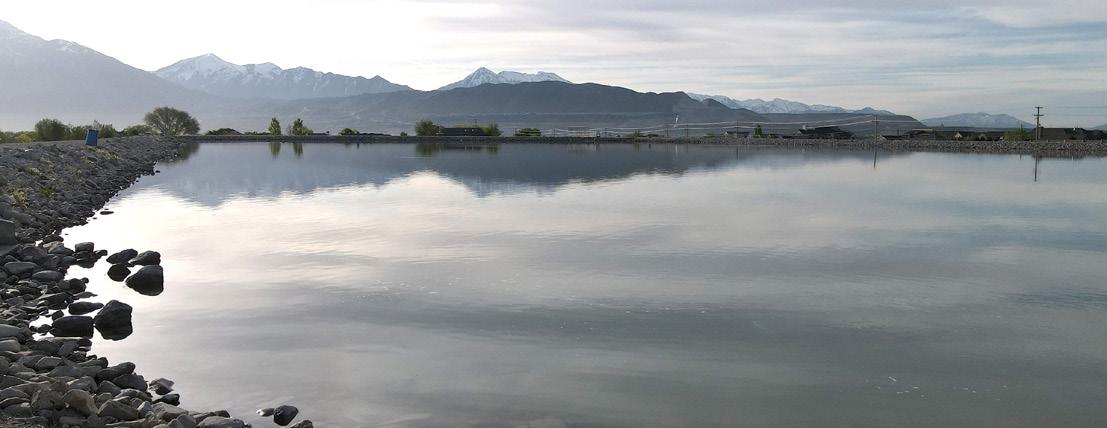

Consumer Confidence Report Report: 2024 Riverton City Water Quality Data
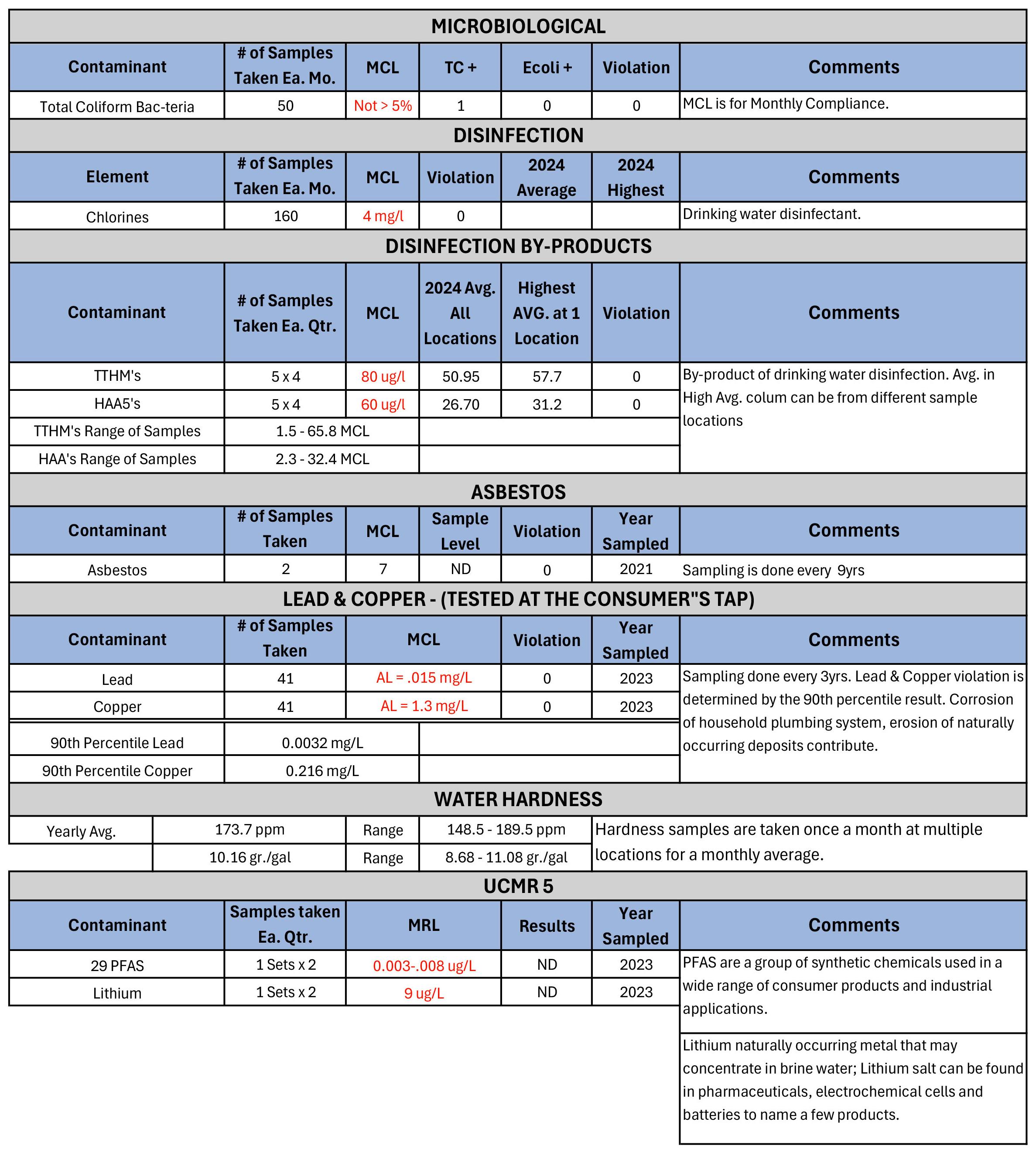

Consumer Confidence Report Data - UCMR 5 2024
Report: UCMR Appendix


Consumer Confidence Report Data 2024
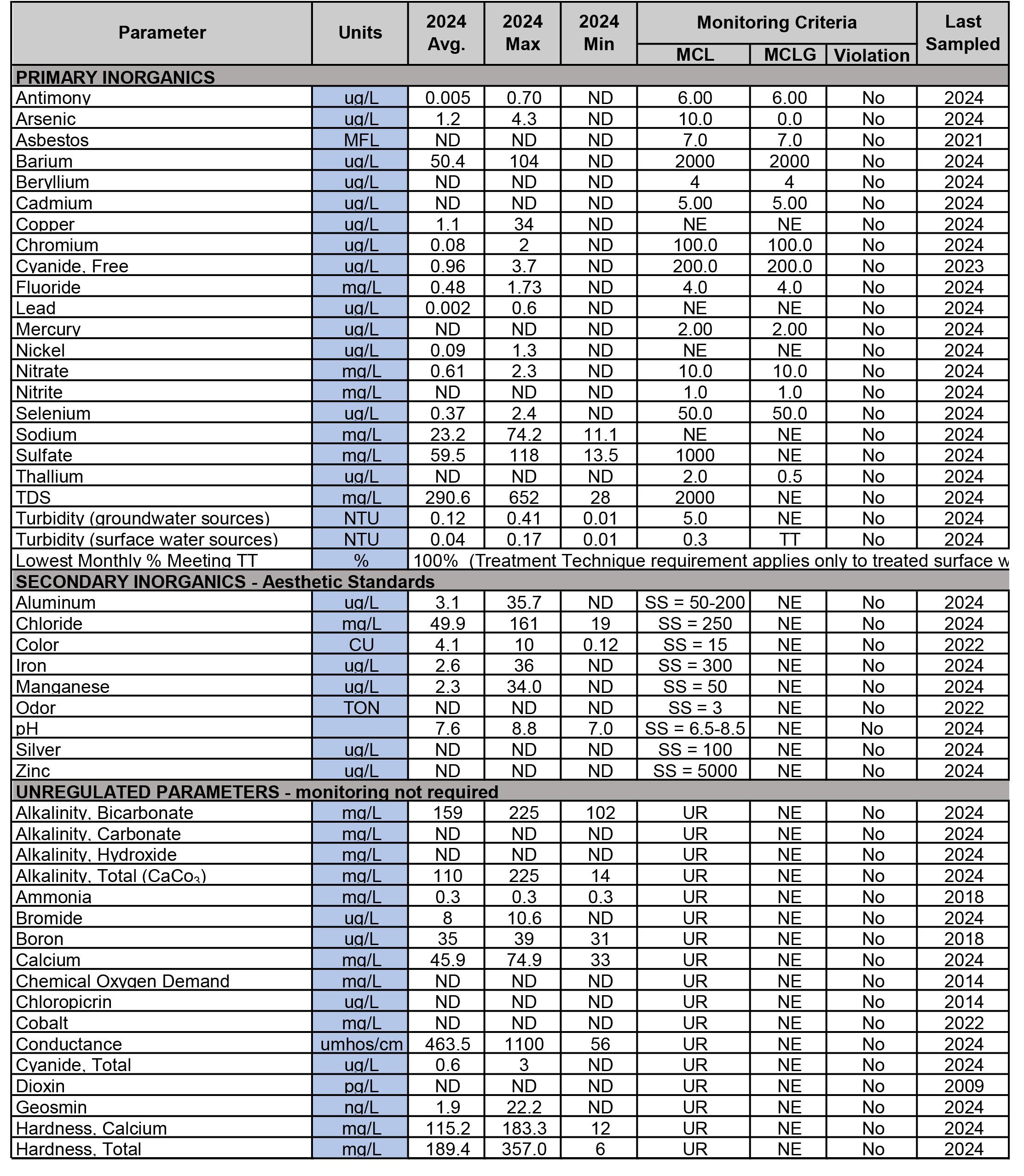
- Chart continued on the next page -

Table 3: Consumer Confidence Report Data 2024 - Continued from previous page -


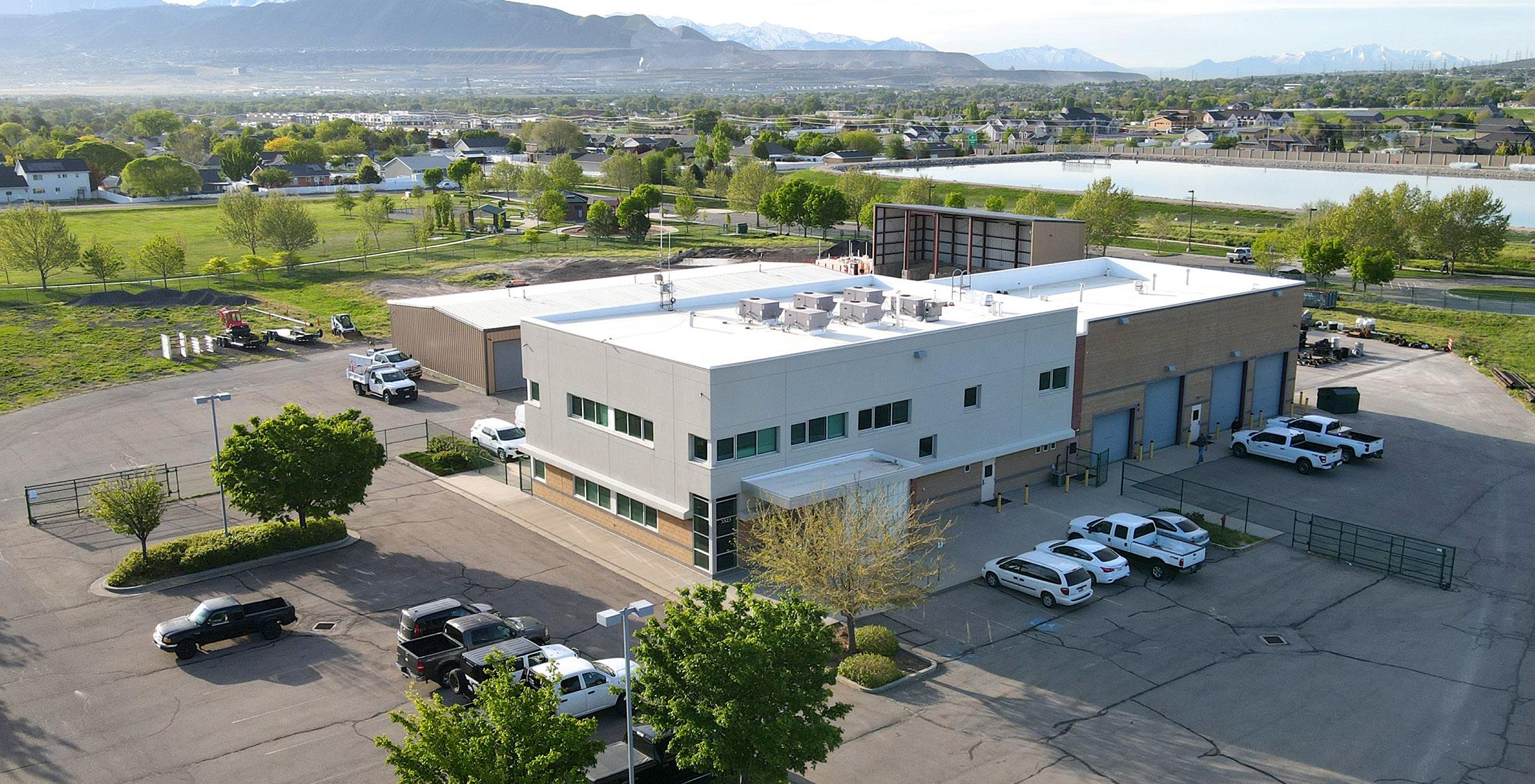

2024 Water Consumer Confidence Report
ELECTED OFFICIALS
Trent Staggs Mayor
Andy Pierucci City Council – District 1
Troy McDougal City Council – District 2
Tawnee McCay City Council – District 3
Tish Buroker City Council – District 4
Spencer Haymond City Council – District 5
WATER DEPARTMENT
Cary Necaise Public Works Director
Stacie Olson Assistant Public Works Director
Kal McDonald Water Manager
Darcy Lowry Assistant Water Manager